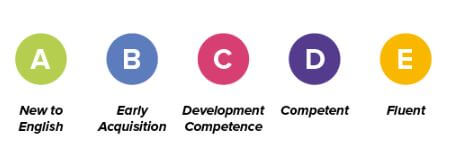

Learning Labs work closely with Pupil and School Support, to ensure the FlashAcademy® EAL platform is as impactful as possible for the classroom. We caught up with Terri Cawser, an Assistant Service Lead, to talk about the best ways to conduct EAL Proficiency Assessment.

Can you tell us what the Proficiency Assessment means for schools?
It was announced in June that there is no longer a requirement for schools to report on the level of proficiency in English of pupils for whom English is not their first language. This measure, introduced into the school census in 2016, was initially designed to help the DfE gather data to inform policy decisions for this high-needs group. It was also intended to support schools in distinguishing between EAL pupils who lack a basic command of English and those who are bilingual. Despite the removal of this reporting requirement, EAL proficiency testing for primary and secondary students remains a crucial tool for schools.
Accurate assessment helps educators understand where pupils are in their language development journey and tailor support accordingly. The best practices for assessing EAL learners suggest that ongoing, formative assessment is key to monitoring progress and informing teaching strategies. Schools should continue to develop internal systems that capture a clear picture of each learner’s language ability. There are many resources available to support this work.
Exploring the top EAL assessment tools can help schools select the most effective methods for evaluating English language proficiency. Tools that offer clear frameworks and are aligned with curriculum standards can provide valuable insight into learners’ needs and progress. In short, the removal of statutory reporting should not deter schools from assessing EAL learners. There is still a clear need to track the progress of bilingual students to ensure that teaching and provision are matched to their individual needs.
How should schools record basic pupil information?
We recommend that schools consider where and when they collect this information – for example, should it be part of the school induction process? It’s also important to consider how the questions are asked of the pupils and whether it’s possible to do this in the home language of the pupil, to help improve the accuracy of the information being collected.
How should pupil’s English proficiency be measured?
This should be measured against a 5-point scale, ranging from ‘New to English’ to ‘Fluent’. This should take into account all core skills of speaking, listening, reading and writing.

Who should carry out these assessments?
Typically, the class teacher supported by an EAL or inclusion co-ordinator.
What assessment tools are available to schools?
Several. Free resources include the Bell Foundation Assessment Profile and within Birmingham, the Pupil and School Support Assessment Framework. I know that FlashAcademy® EAL are also working on a digital version, which we’re looking forward to reviewing.
Why is this important?
It allows schools to better profile the home languages they have across the school, celebrate diversity and also provides important information for the EAL or Inclusion co-ordinator to review the strategic needs of the school.
We’d like to thank Terri Cawser for supplying the text for this blog! Terri Cawser is one of the Assistant Service Leads at Pupil and School Support in Birmingham, a team of 40 teachers who support all mainstream maintained, free schools and academies in the local authority. As well as being responsible for service development at PSS she also leads on EAL for the service. Terri has spent her whole teaching career working in inner city Birmingham schools and has seen the changing profile of EAL first hand providing her with the knowledge and experience to support schools in meeting the needs of their EAL pupils.
Interested in all things EAL? Check out our tips on how to set up an effective EAL team! If you are looking for free EAL resources for your school, why not visit our resources page?

